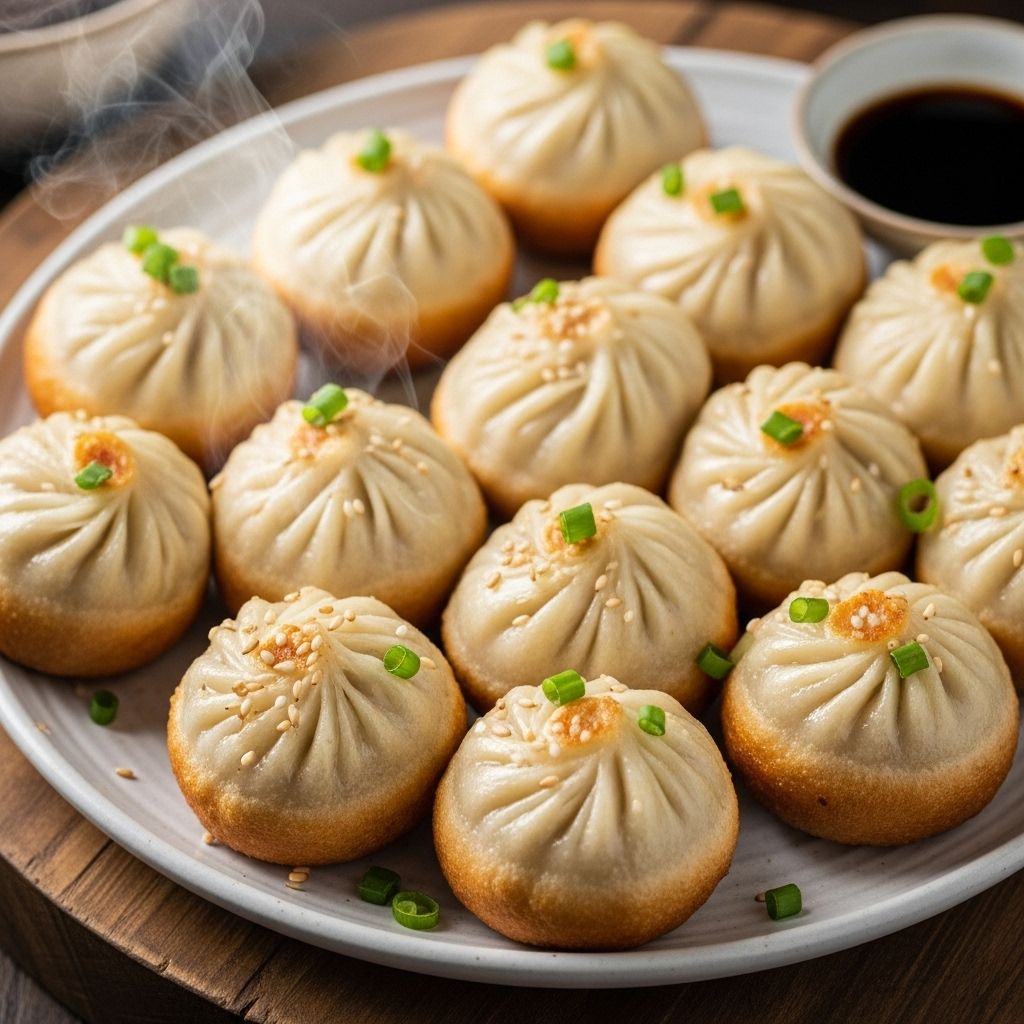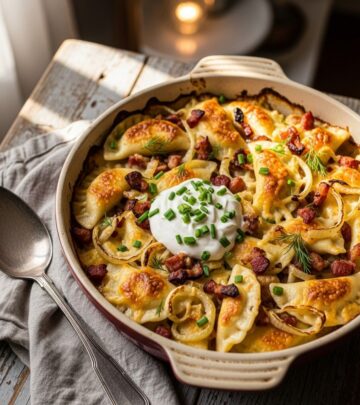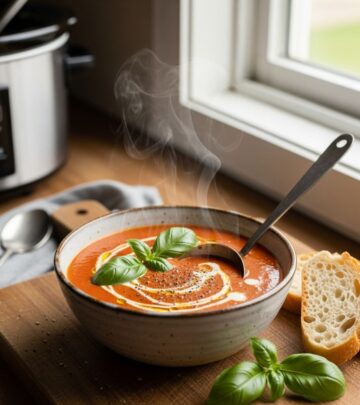Sheng Jian Bao: Pan-Fried Pork Soup Dumplings Recipe
Master the art of Sheng Jian Bao—crispy, juicy Shanghai pan-fried pork soup dumplings made at home.

Sheng Jian Bao: Pan-Fried Pork Soup Dumplings
Sheng Jian Bao, often described as the heartier, doughier cousin of xiao long bao, are juicy pork soup dumplings with a satisfyingly crispy bottom. While xiao long bao have captured the imagination of food lovers worldwide, Sheng Jian Bao (SJB) remain a cherished secret for many. These Shanghai-style pan-fried buns boast a deeply savory pork filling, a delicate yet bready dough, and a unique cooking technique that combines pan frying and steaming. This recipe guides you through every step, from the rich filling to perfect pleating and the signature golden crust, so you can savor authentic Sheng Jian Bao at home.
Why Sheng Jian Bao Deserve the Spotlight
- Textural contrast: Fluffy bread-like dough with a crispy, golden base.
- Juicy filling: Pork, aromatics, and often hidden gelatin that melts into a burst of soup.
- Distinct cooking method: Both steamed and fried in the same pan for maximum flavor and texture.
Ingredients for Authentic Sheng Jian Bao
This recipe is designed to yield about 24 dumplings—enough for a crowd or several dim sum feasts at home.
For the Pork Filling
- 1 cup shredded Napa cabbage (from about 2 to 3 leaves)
- 1 teaspoon kosher salt
- 3/4 pound pork belly, cut into 1-inch cubes
- 2 dried shiitake mushrooms (soaked until soft, drained, squeezed, finely chopped)
- 1 scallion, finely chopped
- 2 cloves garlic, minced
- 2 teaspoons cornstarch
- 1 teaspoon Shaoxing wine
- 1 teaspoon toasted sesame oil
- 1 teaspoon vegetable, peanut, or canola oil
- 1/4 teaspoon sugar
- 1/4 teaspoon ground white pepper
For the Dough
- 2 cups (10 ounces) all-purpose flour
- 2 teaspoons cornstarch
- 1/2 teaspoon kosher salt
- 1 tablespoon sugar
- 1 teaspoon instant yeast
- 1 teaspoon baking powder
- 3/4 cup whole milk, warmed to about 110°F (43°C)
To Finish
- Vegetable oil, for frying
- 1 cup water
- Chopped scallions and toasted sesame seeds (for garnish – optional)
Step-By-Step Directions
Making the Pork Filling
- Place the shredded Napa cabbage in a bowl. Sprinkle with salt, toss, and let sit for about 10 minutes to draw out excess water. Squeeze firmly to remove additional moisture and return to the bowl.
- Using a food processor, grind the pork belly until fine. Add the drained cabbage, chopped shiitake mushrooms, scallion, and garlic. Pulse until just incorporated—do not over-process.
- Transfer the mixture to a large bowl. Add cornstarch, Shaoxing wine, sesame oil, vegetable oil, sugar, and white pepper. Mix until cohesive and slightly sticky. Cover and refrigerate for at least 30 minutes, or up to 1 day ahead, to enhance the flavors.
Preparing the Dough
- In a large bowl, whisk together flour, cornstarch, salt, sugar, baking powder, and yeast.
- Add half the warm milk and mix with a spatula. Add remaining milk and stir until a shaggy dough forms.
- Transfer the dough onto a lightly floured surface and knead until it becomes smooth and elastic, about 7–10 minutes. The dough should be soft but not sticky.
- Grease a separate bowl, add the dough, and cover tightly. Let rise in a warm spot until doubled in size, about 30–45 minutes.
Assembling the Sheng Jian Bao
- Transfer dough to a lightly floured work surface. Divide into four equal pieces. Roll each into a log and cut each into six pieces, yielding 24 portions.
- Shape each piece into a ball, then flatten into a disc about 3.5 inches in diameter. Keep unused dough covered to prevent drying.
- Place about 1 tablespoon of pork filling in the center of each dough circle.
- Pleat and pinch the edges up and around the filling. Gather and twist to seal the top. Rest filled buns, seam side up, on a parchment-lined baking sheet.
Cooking: Pan-Frying and Steaming
The dual cooking method creates Sheng Jian Bao’s characteristic texture—crunchy on the bottom, pillowy on top.
- Pour enough vegetable oil to lightly coat the bottom of a large nonstick or cast iron skillet. Arrange buns in the pan, seam side down, leaving a little space between them.
- Cover with a lid. Cook over medium heat until the bottoms are golden brown, about 2–3 minutes.
- Carefully pour in enough water to come about a third of the way up the sides of the buns (approximately 1 cup). Cover immediately to trap steam.
- Steam the buns until most of the liquid evaporates and the tops are cooked through, about 8–10 minutes. Uncover and cook an additional 1–2 minutes to recrisp the bottoms.
- Remove from the pan. Sprinkle with chopped scallions and sesame seeds if desired. Serve hot.
Table: Sheng Jian Bao Cooking Method Overview
| Step | Technique | Purpose | Duration |
|---|---|---|---|
| 1 | Pan-Fry, Covered | Create golden-brown base | 2–3 min |
| 2 | Add Water & Steam | Cook filling and soften tops | 8–10 min |
| 3 | Uncover & Crisp | Finish and re-crisp base | 1–2 min |
Key Tips and Troubleshooting
- Finely chop filling components: Proper texture and easy shaping rely on finely chopped or ground meat and aromatics.
- Prevent soggy dough: Squeeze cabbage thoroughly to avoid excess moisture.
- Adjust dough softness: If dough is too sticky, add flour a tablespoon at a time; if too dry, knead in a touch of water.
- Seal thoroughly: Pinch the top tightly to minimize leakage.
- Avoid overcrowding the pan: Buns expand while cooking, so give enough room.
- Use a nonstick or well-seasoned pan: Ensures easy release and a crisp bottom.
Variations and Serving Suggestions
- Classic accompaniment: Serve with Chinese black vinegar and thinly sliced ginger.
- Vegetarian filling: Substitute pork with finely chopped mushrooms, more cabbage, and silken tofu for a satisfying alternative.
- Make-ahead tips: Freeze uncooked buns on a tray, then store in a zip-top bag. Cook directly from frozen, adding a few extra minutes of steaming.
- Customize the filling: Swap pork belly for ground pork shoulder, beef, or a blend for different flavors and textures.
Understanding Sheng Jian Bao
Originating in early 20th-century Shanghai, Sheng Jian Bao is a breakfast staple and a street food icon. Unlike steamed baozi, their pan-fried preparation brings a contrast of caramelization and pillowy softness. A signature feature is the soup inside the buns—achieved through the natural gelatin in pork belly or by adding aspic that melts during cooking. Each bun is crafted to deliver a burst of savory broth with every bite, a testament to Shanghai’s culinary ingenuity.
Sheng Jian Bao vs. Xiao Long Bao
| Feature | Sheng Jian Bao | Xiao Long Bao |
|---|---|---|
| Wrapper | Thick, bread-like, leavened | Thin, unleavened |
| Cooking Method | Pan-fried then steamed | Steamed |
| Soup Inside | Yes, naturally or with aspic | Yes, aspic melts during steaming |
| Texture | Crispy base, fluffy top | Delicate, silky |
| Size | Larger, heartier | Smaller, daintier |
Storage and Reheating
- To Store Uncooked Bao: Place shaped buns on a baking sheet, freeze until solid, then store in a sealed bag for up to 2 months. Cook from frozen, allowing a few extra minutes of steaming.
- To Store Cooked Bao: Refrigerate leftovers in an airtight container for up to 2 days. Re-crisp in a covered nonstick skillet with a splash of water, until hot throughout.
Frequently Asked Questions (FAQs)
Q: Can I make Sheng Jian Bao with store-bought dough?
A: While you can use prepared pizza or bread dough in a pinch, homemade dough achieves the authentic airiness and flavor crucial to Sheng Jian Bao.
Q: How do you keep the soup inside the dumplings?
A: Use fatty pork or add pork aspic to the filling. Seal each bun tightly to prevent leaks and handle gently during cooking.
Q: Can Sheng Jian Bao be made vegetarian?
A: Yes. Fill with a mixture of mushrooms, napa cabbage, tofu, and glass noodles for a delightful plant-based variation.
Q: What’s the best way to serve Sheng Jian Bao?
A: Serve hot from the pan, with black vinegar and slivers of fresh ginger. Add a light side of pickled vegetables for contrast.
Q: Why is my dough tough or dry?
A: Over-kneading, using too much flour, or skimping on the rising can make the dough dense. Aim for a soft, smooth, and elastic dough that springs back gently when pressed.
Nutritional Considerations
Sheng Jian Bao is a celebration food, rich and satisfying. While higher in fat due to pork belly and the pan-frying method, they can be made lighter with leaner pork cuts and increased vegetables. Each dumpling typically contains a harmonious blend of carbohydrates, protein, and fat—perfect for an occasional indulgence.
Final Thoughts
With their irresistible combination of golden crust, pillowy dough, and savory-soupy center, Sheng Jian Bao are a triumph of Shanghai’s dim sum tradition. Mastering their preparation rewards you with an unforgettable dumpling experience. Gather friends or family, and let each batch transport you straight to a bustling street corner in Shanghai, one sizzling pan at a time.
Read full bio of Sneha Tete












